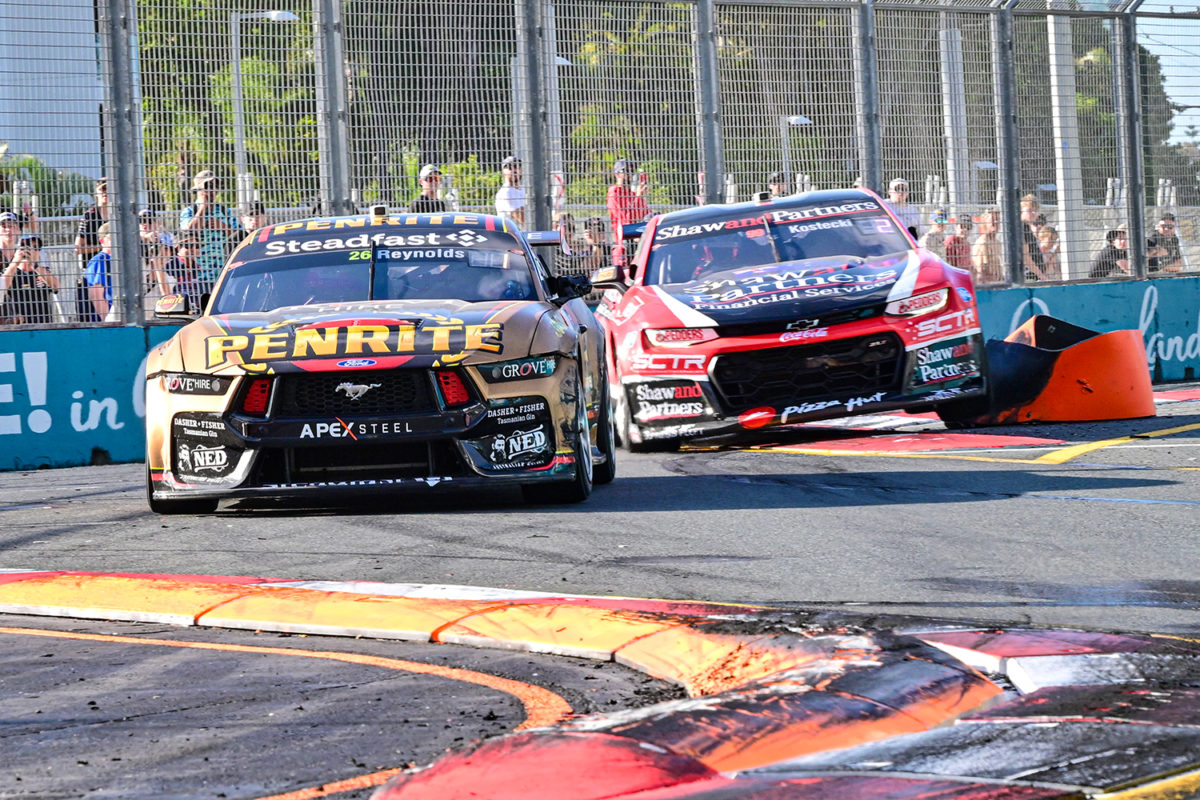

David Reynolds’ final-lap shortcut was a controversial moment of the Boost Mobile Gold Coast 500 and that is the topic which we are exploring in this week’s Pirtek Poll.
The Penrite Racing driver clinched a 0.1889s win over Repco Supercars Championship leader Brodie Kostecki after cutting Turn 2 of the front chicane on the 85th and final lap of Race 26.
It was a moment which gave Reynolds ever so slightly more breathing space and hence probably took a Kostecki dive at the hairpin off the table.
Importantly, it was ‘legal’ in so much that Reynolds was not on a bad sportsmanship flag for track limits breaches, notwithstanding that he had done the same thing on Lap 71 and on Lap 79.
Barry Ryan, Kostecki’s team boss, was apparently unimpressed about the Lap 85 incident based on his body language in the Erebus Motorsport bunker.
Understandably, he still seemed displeased about the matter when queried on it by Speedcafe in the post-race press conference, but commented that the nature of the Surfers Paradise Street Circuit lends itself to such actions.
“This track lends itself to having a bit of a lend of the rules if you want to,” said Ryan.
The question we put to you, then, is whether a final-lap track limits breach should be automatically penalised, regardless of how many a driver has already committed?
MotoGP provides an example of how such a rule might work.
Track limits have become a regular source of angst in the world’s premier two-wheel championship given the modern-day proliferation of painted run-off areas.
As in Supercars, MotoGP riders have a set number of track limits breaches before they are issued a warning, after which a Long Lap Penalty applies.
However, a breach on the final lap automatically results in a position drop penalty if bikes are in close quarters.
The idea is to prevent riders from deliberately using up the run-off area as additional exit space in order to carry more speed.
In Reynolds’ case, though, the shortcutting of the chicane was not necessarily deliberate, or at least not premeditated.
He claims that the proximity of Kostecki’s #99 Camaro to the rear of his #26 Mustang disturbed the airflow over his wing.
That is consistent with the fact that, immediately before each of the three shortcuts, Car #26 broke loose in the rear with Car #99 running close behind.
“They’ve got a bit more straight-line speed, so they can tow up behind me and, in the braking zone, take our aero off us,” said the Grove Racing pilot on Fox Sports.
It is also consistent with a comment from Kostecki on television post-race, when he referred to the challenge of losing downforce with cars behind.
“For the first time, I actually thought it was a disadvantage to be the lead car,” he said on television post-race.
“Every time someone was close to your rear bumper, it made the car really taily.
“So, I was able to use that on Dave and get his rears [tyres] hot, and when he was behind me, close to me, he did the same thing to me.”
Reynolds arguably could have made more effort to make the corner on each occasion, but that would have materially raised the risk of a crash which Kostecki most likely would have been caught in as well.
Even so, if the Erebus driver used his pace and racecraft to force the car in front into a wobble, without making contact, then he could quite reasonably argue that he should earn some reward for that.
On the other hand, as Reynolds noted, he earned the opportunity for such indiscretion by not abusing track limits earlier in the race, and it is hardly as though he completely straight-lined the complex, so why should the rules be any different on the final lap?
But, he also knew what he was doing, given he observed, “I didn’t have any bad sportsmanship flags or anything to worry about so I could have cut the kerbs and used that to my advantage.”
That should not be taken as a slight against Reynolds, either. He knew the rules of engagement and he maximised his outcome within those rules.
Smart driving, one might argue, in a sport in which bending the rules where possible is accepted as the norm.
But, should the rules be tightened up? Officials opted not to issue a running count of track limits breaches so that drivers could not exploit any spares in the final laps, but clearly one has at least one cut up their sleeve while ever they have not been issued a bad sportsmanship flag.
Alternatively, one figure in the paddock put to Speedcafe on Sunday, Race Control should provide a running count of track limits breaches and what the threshold is, so that television can display a count on-screen and add a new hype element to the viewing experience.
That, though, is a debate for another time.
For now, we ask you, should a final-lap track limits breach be automatically penalised or not? Cast your vote below in this week’s Pirtek Poll.




















